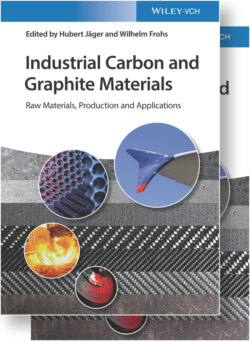Читать книгу Industrial Carbon and Graphite Materials - Группа авторов - Страница 37
3.10 Discovery and Inventions of Nanocarbons: Fullerenes, Nanotubes, and Graphene
ОглавлениеWith the development of high‐resolution electronic microscopy and other modern analytical methods, some different nanocarbon forms were detected and synthesized [17]. Nano‐layers of CVD diamond were already mentioned above. The “buckyball” molecule C60 and higher molecular fullerenes were detected firstly in 1985 in a mass spectrograph by a research group of chemists at the American Rice University (Harold Kroto, Robert Curl, Richard Smalley). These authors won the Nobel Prize in Chemistry in 1996. In 1990 at Heidelberg, the German physicist Wolfgang Krätschmer (together with the American physicist Donald Huffman) firstly synthesized the C50 and higher fullerenes in an electric arc reactor and later transferred into an industrial scale by Hoechst AG. In 1991, the Japanese Sumio Iijima (NEC Corporation at Tsukuba) firstly detected carbon nanotubes as “elongated” form of fullerenes also in an electric arc reactor. They exist in different forms and structures, and many of them up to now are investigated for potential applications.
The newest invention in the field of nanocarbons is related to graphene, i.e. one‐atom thin single layers of graphite. In 2004, Andre Geim and Konstantin Novoselov at the University of Manchester have succeeded in the first preparation of this two‐dimensional allotropic form of carbon and won for this invention the Nobel Prize in Physics in 2010 [18]. This was the second Nobel Prize related to the chemical element carbon! For an overview see Table 3.1.
Table 3.1 Milestones in the history of carbon material.
| Approximately 13 × 109 years ago | The element carbon is formed in the first stars of the universe |
| Approximately 4 × 109 years ago | The first terrestrial diamonds grow in volcanic magma |
| >1 × 109 years ago | The first terrestrial deposits of graphite emerge |
| Approximately 30 000 years ago | Carbon black and charcoal are used as color pigments for cave painting |
| Approximately 8 000 BC | Charcoal is used for the reduction of metal ores |
| Approximately 3 500 BC | Indian ink with carbon black is invented by the Hindu Panningrishee |
| Approx. 1 500 BC | Charcoal powder is used as medicine in Egypt |
| Approx. 500 BC | Celts form ceramic flagons from clay and natural graphite |
| 1220 | Bavarian peasants near Passau win natural graphite for crucibles and cart grease |
| 1456 | Johannes Gutenberg prints the Bible in Mainz with printer’s ink (carbon black) |
| 1565 | Pencils with natural graphite are manufactured by sheep farmers in Cumberland |
| 1709 | Coal coke is used in a blast furnace by Abraham Darby I at Coalbrookdale (England) |
| 1772 | Graphite and diamond are identified as elemental carbon by Antoine Lavoisier |
| 1810 | The first electric arc with charcoal is generated by Humphry Davy in London |
| 1822 | Carbon black is produced from natural gas by Samuel and Godfrey Cabot in the United States |
| 1844 | The first useful arc lamp with carbon rods is constructed by Léon Foucault in Paris |
| 1854 | Aluminum is manufactured with carbon electrodes by Robert Bunsen in Heidelberg |
| 1866 | Werner Siemens constructs the dynamo with carbon brushes in Berlin |
| 1878 | Joseph Swan and Thomas a. Edison invent filament lamps with carbon fibers |
| 1886 | Aluminum is produced with carbon electrodes by Charles Hall and Paul Héroult |
| 1892 | Chlor‐alkali electrolysis with Hg and carbon anodes, invented by Hamilton Y. Castner |
| 1893 | Synthetic graphite by lengthwise graphitization, invented by Hamilton Y. Castner |
| 1895 | Synthetic graphite by crosswise graphitization, invented by Edward G. Acheson |
| 1900 | R. Von Ostrejko invents activated carbon by chemical and gas activation |
| 1909 | The industrial production of activated carbon from charcoal starts at Ratibor (Silesia) |
| 1925 | Carbon black produced by the furnace black process, developed in the United States |
| 1935 | Carbon black from tar aromatics by the Degussa gas black process (Harry Kloepfer) |
| 1942 | Enrico Fermi constructs the first nuclear reactor with reactor graphite in Chicago |
| 1955 | General Electric starts the industrial diamond synthesis by the high‐pressure process |
| 1956 | Boris Spitzyn and Boris Derjaguin invent the low‐pressure diamond synthesis |
| 1958 | General Electric starts the production of glass‐like carbon shapes |
| 1965 | J. D. Brooks and G. H. Taylor discover the carbon mesophase in coal‐tar pitch |
| 1985 | H. W. Kroto, R. F. Curl, and R. E. Smalley discover the fullerenes |
| 1990 | W. Krätschmer et al. invent the fullerene synthesis by the electric arc process |
| 1991 | Sumio Iijima discovers the carbon nanotubes in the NEC laboratory of Tsukuba |
